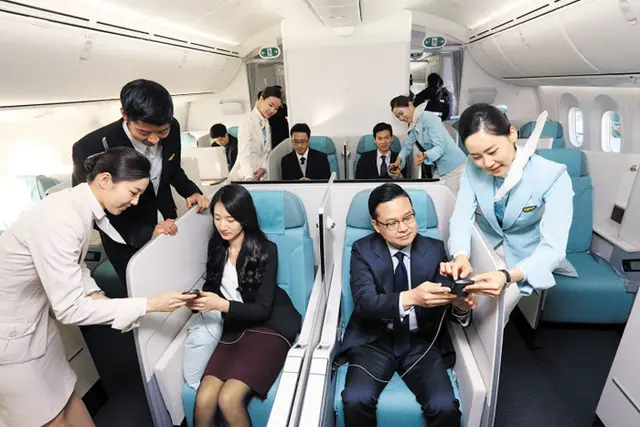Korean Air unveiled the newest addition to its fleet at a press conference in Incheon on Monday.
Korean Air president Cho Won-tae told reporters that the Boeing B787-9, which the flag carrier took delivery of in Seattle last week, is a high-tech passenger jet with low fuel consumption and adequate seating capacity. The B787 is a mid-sized passenger plane, but its state-of-the-art composite airframe enables long-haul flights.
Korean Air will deploy the B787 on the short-haul Gimpo-Jeju route starting in March, before introducing it on long-haul flights to Los Angeles, Madrid and Toronto in June. It plans to buy another 10 B787s by 2019 for long-haul flights, supplementing the Airbus A380 superjumbos it currently operates on flights to New York, Paris and other key routes.
Korean Air crew demonstrate passenger service at the unveiling of the Boeing B787-9 on Monday.
In terms of comfort, the B787's seating rivals that of the larger A380. The distance between seats in economy class is 34 inches, like the A380, while its sliding-type seats do not restrict the leg room of passengers in the row behind when in the reclining position. Business class seats recline 180 degrees and come with a barrier and their own mini-corridor leading to the aisle. They are virtually identical to first class seats, except for their smaller monitors.
Another new feature of the B787 is lower cabin pressure, which the carrier claims reduces passenger fatigue. Its pressure is equivalent to an altitude of 1,800 m, compared to 2,400 m for Boeing's other mid-sized plane, the B777-20. The humidity level, meanwhile, is 15 to 16 percent, compared to just 11 percent on most passenger planes.
Korean Air crew pose in front of the flag carrier's new Boeing 787-9 on Monday
Ma Won, a managing director at Korean Air, said, "The secret is the use of carbon composite materials, which comprise 50 percent of the aircraft's body."
While the bodies of most existing passenger jets are assembled from several pieces of aluminum alloy, the B787's composite hull is nearly seamless. This means it can endure pressure more effectively than aluminum aircraft, allowing lower cabin pressure. And as the carbon composite materials are better able to withstand humidity and do not corrode easily, cabin humidity levels can be raised.
The windows on the B787 do not have covers. Instead, a special gel inside the glass enables passengers to control the opacity. LED lights inside the aircraft vary in luminosity to simulate 14 different times of day.
The B787 is 20 percent more fuel efficient than existing aircraft, as the carbon composite materials make it lighter. Korean Air developed some of the new technologies adopted by Boeing in designing the plane.
"Korean Air is the only carrier in the world that produces aircraft components. We supplied six core components to the B787," Cho said. One of them is the raked wingtip, which makes the aircraft more aerodynamic and boosts fuel efficiency by 5 percent. The plane also makes less noise than the B767, and its flight control system can sense turbulence and reduce rattling.
(THE CHOSUNILBO)
 简体中文
简体中文

